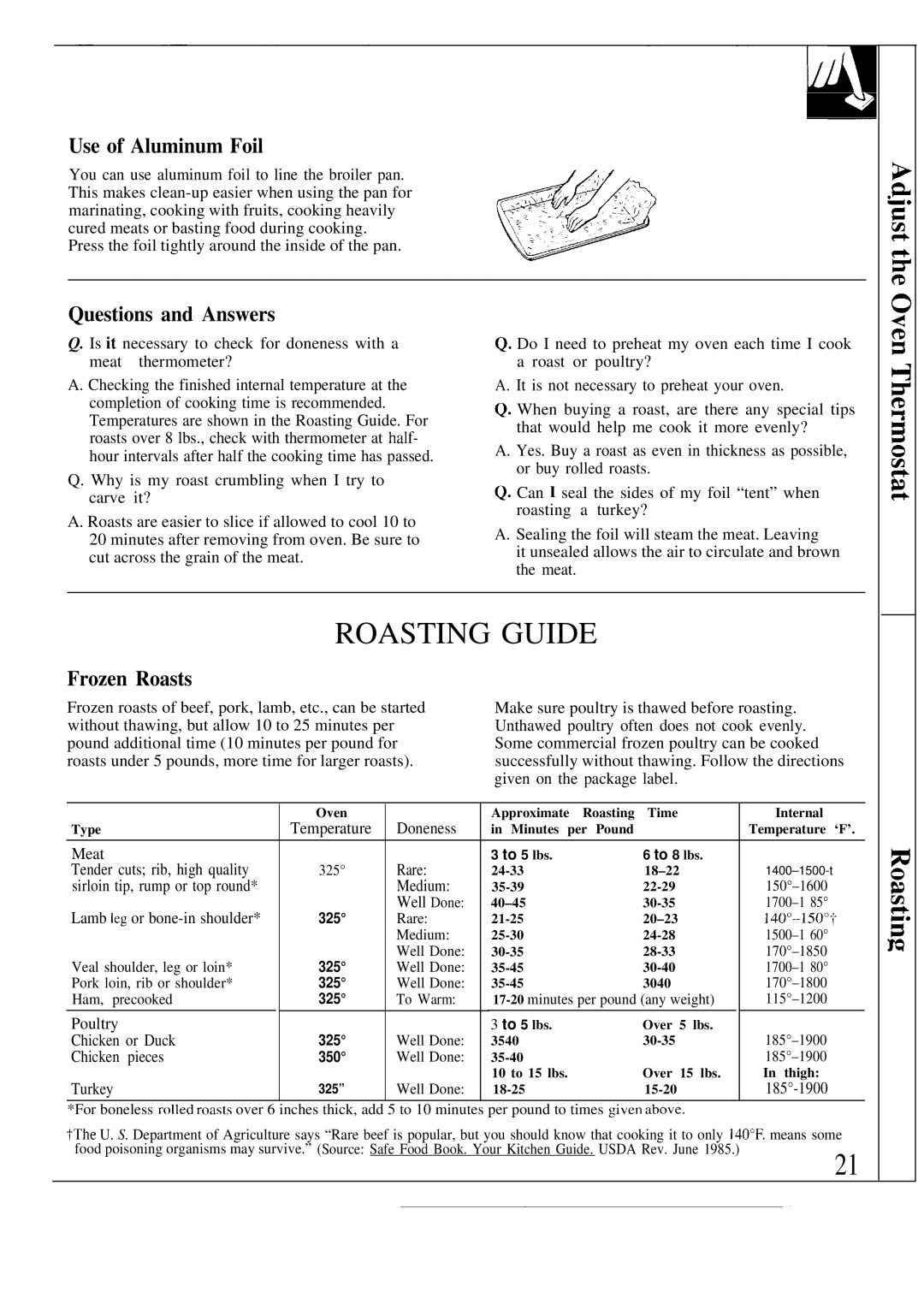
Use of Aluminum Foil
You can use aluminum foil to line the broiler pan. This makes
Press the foil tightly around the inside of the pan.
Questions and Answers
Q. Is it necessary to check for doneness with a meat thermometer?
A. Checking the finished internal temperature at the
completion of cooking time is recommended. Temperatures are shown in the Roasting Guide. For roasts over 8 lbs., check with thermometer at half- hour intervals after half the cooking time has passed.
Q. Why is my roast crumbling when I try to carve it?
A. Roasts are easier to slice if allowed to cool 10 to 20 minutes after removing from oven. Be sure to cut across the grain of the meat.
Q. Do I need to preheat my oven each time I cook a roast or poultry?
A. It is not necessary to preheat your oven.
Q. When buying a roast, are there any special tips that would help me cook it more evenly?
A. Yes. Buy a roast as even in thickness as possible, or buy rolled roasts.
Q. Can I seal the sides of my foil “tent” when roasting a turkey?
A.Sealing the foil will steam the meat. Leaving
it unsealed allows the air to circulate and brown the meat.
ROASTING GUIDE
Frozen Roasts
Frozen roasts of beef, pork, lamb, etc., can be started without thawing, but allow 10 to 25 minutes per pound additional time (10 minutes per pound for roasts under 5 pounds, more time for larger roasts).
Make sure poultry is thawed before roasting. Unthawed poultry often does not cook evenly. Some commercial frozen poultry can be cooked successfully without thawing. Follow the directions given on the package label.
|
| Oven |
| Approximate Roasting | Time |
|
| Internal |
Type | Temperature | Doneness | in Minutes per Pound |
|
|
| Temperature ‘F’. | |
|
|
|
|
|
|
|
| |
Meat |
|
| 3 to 5 lbs. | 6 to 8 lbs. |
| |||
Tender cuts; rib, high quality | 325° | Rare: | ||||||
sirloin tip, rump or top round* |
| Medium: |
|
| ||||
Lamb leg or | 325° | Well Done: |
|
| ||||
Rare: |
|
| ||||||
|
|
| Medium: |
|
| |||
|
| 325° | Well Done: |
|
| |||
Veal shoulder, leg or loin* | Well Done: |
|
| |||||
Pork loin, rib or shoulder* | 325° | Well Done: | 3040 |
|
| |||
Ham, precooked | 325° | To Warm: | ||||||
|
|
|
|
|
|
|
|
|
Poultry |
|
| 3 to 5 lbs. | Over | 5 lbs. |
| ||
Chicken or Duck | 325° | Well Done: | 3540 |
|
| |||
Chicken pieces | 350° | Well Done: |
|
|
| |||
|
|
|
| 10 to 15 lbs. | Over | 15 lbs. | In thigh: | |
Turkey | 325” | Well Done: |
|
|
| |||
*For boneless rolled roasts over 6 inches thick, add 5 to 10 minutes per pound to times given above.
7The U. S. Department of Agriculture says “Rare beef is popular, but you should know that cooking it to only 140”F. means some
food poisoning organisms may survive.” (Source: Safe Food Book. Your Kitchen Guide. USDA Rev. June 1985.)
21
—-—
